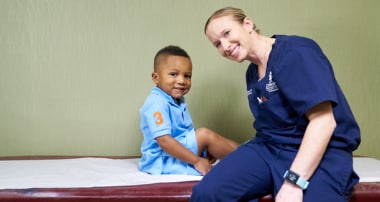Hip Abduction Brace
A hip abduction brace, or rhino cruiser, is prescribed for some patients with developmental dysplasia of the hip (DDH), which is also called hip dysplasia.
Hip dysplasia can be present at birth or develop as your child grows. It describes a wide range of problems, such as a misshapen joint ball or socket, or a loose hip joint. It occurs in 1 in 1,000 births and can run in families or be caused by something in the baby’s environment in the mother’s womb.
A hip abduction brace is a foam and plastic brace that:
- Wraps snugly around the waist and each thigh.
- Keeps your child’s legs and hip joints spread apart.
- Keeps his hips stable so they can develop properly.
- May be worn at night or all day and night depending on his needs and the doctor’s prescription.
- May require several months of wear to achieve desired correction.

Quinn’s journey with hip dysplasia and a spica cast
Quinn was diagnosed with developmental dysplasia of the hip (DDH), also known as hip dysplasia. Our team of specialists helped correct her hips through surgery, casting and bracing.
Read Her StoryIn many cases, your child may have just had a cast or splint removed before getting fitted for his hip abduction brace. The area may be bruised, swollen or tender to the touch. Let your child know this is normal. Be sure to wash away any dry skin from the cast or splint area before your child is fitted for his new brace.
Your child’s orthotist will measure your child and fit him for his new brace. The orthotist will also teach you how to put on your child’s hip abduction brace. Infants are able to learn to roll, sit, commando crawl while in the brace, and toddlers can actually walk in the brace. However, crawling on hands and knees is not recommended.
General guidelines for putting a hip abduction brace on your child:
- Put a fresh diaper and clean pants on your child. Clean the brace if needed.
- Place your hands under your child’s bottom. Lift his bottom up with your hands. Apply the brace under his bottom. Do not lift your child by his legs.
- Wrap the foam around your child’s thighs. Secure the fabric fastener straps snugly around his waist and each thigh.
- Dress your child in a diaper and a pair of thin, stretchy pants or tights. They should not have any zippers or snaps or a thick waistband.
- Your child may need a special car seat. This will depend on their size and how long they will be wearing the brace. Your physician/nurse will help you determine if your current car seat is suitable or if a HIPPO options might be better.
To keep your child’s skin, hips and brace in good condition:
- Do not exceed the brace-wearing limits prescribed by your child’s doctor or orthotist.
- Keep the brace away from space heaters or other forms of heat. Heat can melt the foam or plastic and damage the brace. It can also injure your child.
How do I clean the brace?
- Each day, dampen a washcloth with rubbing alcohol and clean the brace.
- Dry as needed before putting the brace back on your child.
Contact your child’s doctor or orthotist if:
- You have concerns about the fit of your child's brace. As your child grows, the fit of his brace will change. A new prescription from the doctor will be needed for a new brace.
- Your child has the following skin problems:
- Redness that does not fade after 30 minutes
- White areas or blisters
- Hard skin or calluses
- You have questions about your child’s brace.
The brace is designed to provide a stable way for the hips to heal. However, the brace may:
- Cause too much pressure or friction on the skin.
- Be worn too loosely, preventing the hips from healing properly.
- Increase sweating.
- Increase your child’s risk of falling due to the way the brace holds the hips. Have your child learn to walk in the brace in a safe area.
We suggest requesting an appointment on the same day you have a concern or the next business day. To schedule an appointment, call 404-785-3229. On weekends or holidays, your child should wear the brace as tolerated and you should call the next business day. If your child needs a new brace, the doctor will need to write a new order for one.
Support on Facebook
This content is general information and is not specific medical advice. Always consult with a doctor or healthcare provider if you have any questions or concerns about the health of a child. In case of an urgent concern or emergency, call 911 or go to the nearest emergency department right away. Some physicians and affiliated healthcare professionals on the Children’s Healthcare of Atlanta team are independent providers and are not our employees.
Contact Us 404-785-3229

